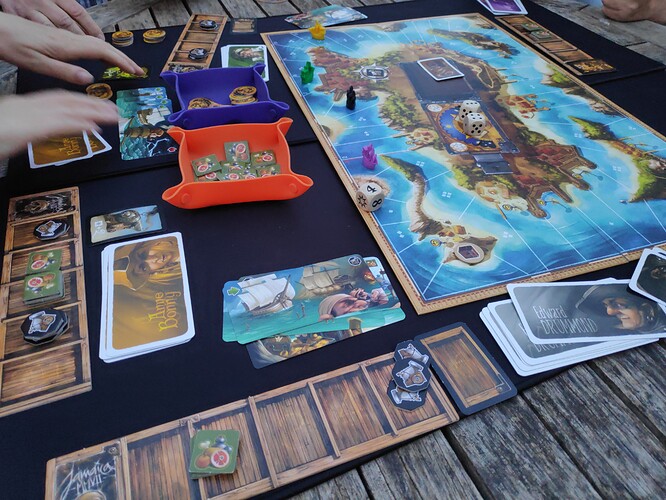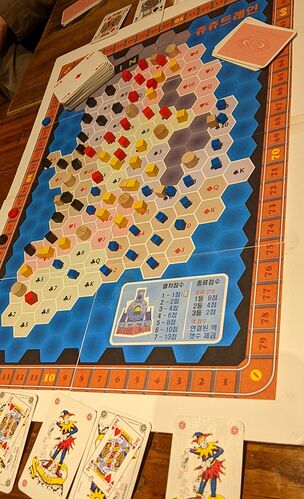…and success! It took me two runs to get there, after making tactical errors in the first run which left me starved for options and finally out of luck.
Impressions then:
The Dead Eye is a solo deck-building game, essentially. There are 14 standard ‘core’ cards that you start every run with, and a kind of market (albeit not thematically) of two face-down piles of 5 cards each – one with ‘good’ cards (juice) and the other with ‘bad’ cards (heat) – from which you will either choose or be forced to add cards to your deck as the game progresses. If you are ever required to take a card from a pile which has been depleted, you fail the run – and as one of the 14 start cards (‘Tox’) forces you to add a card from the bad pile every time it appears, the duration of each run is limited (although the first of the three sets of ‘destination’ cards enables a card combo which can bypass the Tox event).
These two piles of 5 are dealt randomly from the 12+12 cards in the box, leaving 7 of each in ‘reserve’; and every time you end a run (success or failure) you randomly replace 1 of each with a reserve, retiring the cards that you’ve removed. Hence you can make a maximum of 8 runs in a game, and your juice/heat ‘market’ piles will be slightly different for each run, and your starting set is likely quite different from one game to the next.
Thematically, you’re traversing a sci-fi wasteland trying to get from one safe haven to the next, and the market is your remaining ‘strength’ and ‘hope’. There’s some thematic art and flavour text, but the theme feels very light to me, and I’m not convinced this is going to change.
Every card in the game is multi-use. Almost every card can be a potential ‘encounter’ with both a good and a bad outcome possible; and almost every card can be spent as ‘heat’ or ‘juice’ to influence which of those outcomes you’ll get for the current encounter. The outcomes themselves are mostly either ‘distance’ (helping you towards the next safe haven), or ‘parts’ (special abilities which largely help you to manage your current heat and juice, but which include some other special-case abilities as well).
Once they have become ‘parts’ or ‘distance’, those cards are no longer part of your deck; so you start with your standard 14 cards (7 juice, 7 heat); acquire more cards from the two piles of 5 during the game; acquire the 3-4 ‘destination’ cards for each run as your fulfil their requirements; and attempt to eliminate cards from your deck as either ‘parts’ or ‘distance’ by achieving the good outcome when that card is the current ‘encounter’. You want parts to help you manage the random elements, and you want distance in order to reach the next safe haven.
Draw too much heat and you’ll get the bad outcome; otherwise, with enough juice, you’ll get the good outcome (each encounter specifies thresholds for both). You’re always drawing heat and juice from your face-down deck – but while the 14 start cards are not distinguishable face-down, the card backs of the two piles of 5 are identifiably heat or juice; so as your deck acquires cards from those piles, you will sometimes know what you’ll be drawing next. There’s also a memory element – ‘postponing’ cards happens a lot, and this means that you return the card to your deck, face down, at the bottom. Consequently you often know what the sequence is going to be as you approach the end – and whether or not it’s going to force you into a good or bad outcome – even if the card backs are not identifiable.
It’s not bad. I’m not sure it’s great, though.
After initially thinking the game was brutally difficult, it turned out to be easy enough that I won in my first attempt, despite having played half that game under unintentionally hard house rules. There is a very easy way you can increase the difficulty, though, simply by reducing the number of allowed failures (5) to some smaller number (perhaps even zero).
Thematically, I’m reminded somewhat of The Lost Expedition. The specific gameplay mechanics are rather different, but it still feels like a similar niche – and for me, TLE (and its sibling Judge Dredd: The Cursed Earth) are much more thematic games (even if I have to generate the story in my head, the TLE games give me the prompts to do that in a way that TDE does not). I’ll happily play this game again, but while TLE and JD:TCE are both staying in my collection, I’m uncertain whether or not this one will be sticking around for the long term.
It’s not a bad puzzle; I just don’t know that it has legs longer term. I’ll be genuinely interested to see how easy (or not) I find it, the next time I play…

